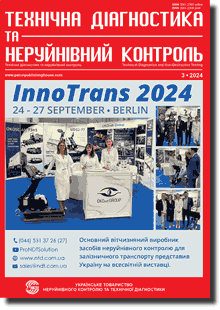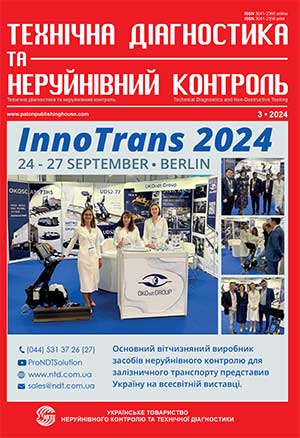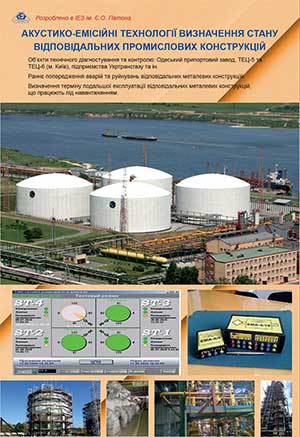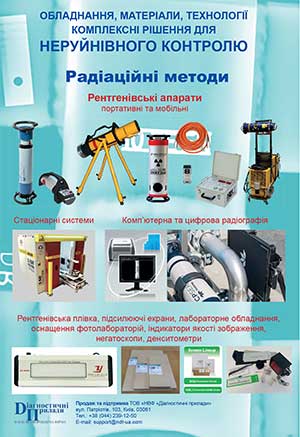| 2024 №03 (08) |
DOI of Article 10.37434/tdnk2024.03.01 |
2024 №03 (02) |

"Tekhnichna Diahnostyka ta Neruinivnyi Kontrol" (Technical Diagnostics and Non-Destructive Testing) #3, 2024, pp. 3-8
Effectiveness of the technology of automated EDDY flaw detection with matrix converters
Ju.Ju. Lysenko1, Ju.V. Kuts1, J. Mirchev2, O.E. Levchenko1, S.M. Glabets3
1NTUU «Igor Sikorsky Kyiv Polytechnic Institute». 37 Beresteysky Ave., 03056, Kyiv, Ukraine. E-mail: j.lysenko@kpi.ua, y.kuts@ukr.net2Institute of Mechanics of Bulgarian Academy of Sciences. Acad. G. Bontchev St., bl. 4 1113 Sofia, Bulgaria. E-mail: mirchev@imbm.bas.bg
3Laboratory of SC LLC «SPF «Diagnostychni prylady». 103 Patiotyv Str., 03061, Kyiv. E-mail: s.glabets@gmail.com
The effectiveness of application of matrix converter method at eddy current testing (ECT) is studied in the work. Advantages of eddy current matrix application are analyzed, which include improvement of sensitivity to small defects, shortening of the total control time and improvement of the probability of detection of various types of defects. To evaluate their effectiveness, a dimensionless coefficient is proposed, which takes into account the inspection time, the reliability of defect detection, and the sensitivity to defects of a certain size. Experimental studies on samples with artificially induced defects of different dimensions, types and orientation confirmed the rationality of application of this coefficient for testing parameter optimization, in order to improve defect detection in structural elements. The influence of various factors, such as condition of the surface, sensor configuration in the matrix and verification parameters on the productivity of ECT hardware and software with matrix converters was additionally analyzed. Obtained results will promote better understanding of the possibilities and limitations of matrix application in ECT of the components of transport, aviation and military equipment. It will allow optimizing the strategies of checking the controlled products, improving the reliability of defect detection and general maintenance practices in many industries. 16 Ref., 2 Tabl., 5 Fig.
Keywords: automated eddy current control, converter matrix, effectiveness, mathematical modelling, flaw detection, signal processing, numerical methods
Received: 31.07.2024
Received in revised form: 30.08.2024
Accepted: 30.09.2024
References
1. Hellier, C. (2001) Handbook of Nondestructive Evaluation. McGraw-Hill.2. Ahmad, A., Bond, L.J. (2002) Non-Destructive evaluation and quality control. Vol. 17. ASM International.
3. Uchanin, V.M., Lutcenko, G.G., Opanasenko, A.V. (2023) Automated EDDY current inspection systems with surface probe of double differential type. The Paton Welding J, 5, 48-56. https://doi.org/10.37434/tpwj2023.05.08
4. ASTM International (2017) ASTM E2884 − 17 Guide for eddy current testing of electrically conducting materials using conformable sensor arrays.
5. EN ISO 20339:2017 Non-destructive testing − Equipment for eddy current examination − Array probe characteristics and verification (ISO 20339:2017).
6. Lysenko, I., Kuts, Y., Uchanin, V. et al. (2023) Problems of using eddy current arrays NDT. In: Pawelczyk M, Bismor D, Ogonowski S, Kacprzyk J, editors. Advanced, Contemporary Control. PCC 2023. Lecture Notes in Networks and Systems, Vol. 708, pp. 287-293. https://doi.org/10.1007/978-3-031-35170-9_27
7. Allard, AM., Grenier, M., Sirois, M., Wassink, C. (2021) Understanding eddy current array for high-performance inspections. Materials Evaluation. https://doi.org/10.32548/2021.me-04226
8. Lamarre, A. (2015) Eddy current array technology serves a variety of industries. Quality magazine. [11.07.2024]. https:// www.qualitymag.com/articles/92427-eddy-current-array-technology-serves-a-variety-of-industries
9. Kuts, Yu.V., Uchanin, V.M., Lysenko, Yu.Yu. et al. (2021) Application of Hilbert transform for analysis of signals of automated eddy current inspection. Part 2. Deriving secondary diagnostic features and examples of realization. Tekhn. Diahnost. ta Neruiniv. Kontrol, 4, 11-18. https://doi.org/10.37434/tdnk2021.04.01
10. Deng, Y., Liu, X. (2011) Electromagnetic imaging methods for nondestructive evaluation applications. Sensors, 11(12), 11774-11808. https://doi.org/10.3390/s111211774
11. Mook, G., Michel, F., Simonin, J. (2011) Electromagnetic imaging using probe arrays. J. of Mechanical Engineering, 57(3), 227-236. https://doi.org/10.5545/sv-jme.2010.173
12. Lysenko, I., Kuts, Y., Uchanin, V. et al. (2024) Evaluation of eddy current array performance in detecting aircraft component defects. Transactions on Aerospace Research, 2024(2), 1-9. https://doi.org/10.2478/tar-2024-0007
13. Uchanin, V.M. (2023) Surface EDDY current probes of double differential type as an effective tool to solve non-destructive inspection problems. The Paton Welding J., 2, 46-55. https://doi.org/10.37434/tpwj2023.02.07
14. Mook, G., Michel, F., Simonin, J. (2008) Electromagnetic imaging using probe arrays. Proc. of 17th World Conf. on Nondestructive Testing, Shanghai. www.ndt.net. https://doi.org/10.5545/sv-jme.2010.173
15. Sun, Z., Cai, D., Zou, Ch. et al. (2017) Design and optimization of a flexible arrayed eddy current sensor. Measurement Science and Technology, 28(4), 8. https://doi.org/10.1088/1361-6501/aa5b76
16. Ma, Q., Gao, B., Tian, G.Y. et al. (2020) High sensitivity flexible double square winding eddy current array for surface micro-defects inspection, Sensors and Actuators A: Physical, 309, 111844. https://doi.org/10.1016/j.sna.2020.111844
Advertising in this issue:
To order the electronic version of the paper:
Ju.Ju. Lysenko, Ju.V. Kuts, J. Mirchev, O.E. Levchenko, S.M. GlabetsEffectiveness of the technology of automated EDDY flaw detection with matrix converters
Technical Diagnostics and Non-Destructive Testing №03 2024 p.3-8
The cost of article (pdf): 13 $, 12 €, 150 UAH (1 copy. )
fill in the form below:
The cost of subscription/purchase order journals or individual articles
| Journal/Currency | Annual Set | 1 issue printed |
1 issue |
one article |
| TPWJ/USD | 384 $ | 32 $ | 26 $ | 13 $ |
| TPWJ/EUR | 348 € | 29 € | 24 € | 12 € |
| TPWJ/UAH | 7200 UAH | 600 UAH | 600 UAH | 280 UAH |
| AS/UAH | 1800 UAH | 300 UAH | 300 UAH | 150 UAH |
| AS/USD | 192 $ | 32 $ | 26 $ | 13 $ |
| AS/EUR | 180 € | 30 € | 25 € | 12 € |
| SEM/UAH | 1200 UAH | 300 UAH | 300 UAH | 150 UAH |
| SEM/USD | 128 $ | 32 $ | 26 $ | 13 $ |
| SEM/EUR | 120 € | 30 € | 25 € | 12 € |
| TDNK/UAH | 1200 UAH | 300 UAH | 300 UAH | 150 UAH |
| TDNK/USD | 128 $ | 32 $ | 26 $ | 13 $ |
| TDNK/EUR | 120 € | 30 € | 25 € | 15 € |
AS = «Automatic Welding» - 6 issues per year;
TPWJ = «PATON WELDING JOURNAL» - 12 issues per year;
SEM = «Electrometallurgy Today» - 4 issues per year;
TDNK = «Technical Diagnostics and Non-Destructive Testing» - 4 issues per year.









